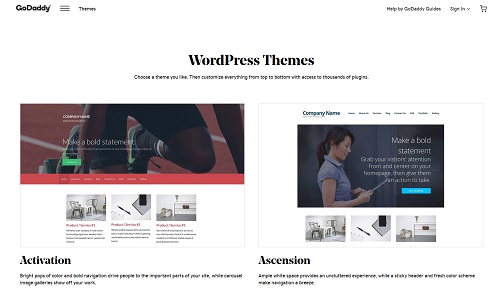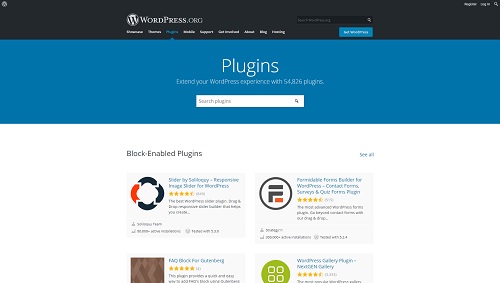How To Create A Blog With Your Own Domain
This post was originally published on Jan. 20, 2016, and was updated on May 2, 2017, Jan. 10, 2018, Nov. 28, 2018, Jan. 7, 2020, and Feb. 17, 2021.
When I started blogging in 2009, the market wasn't quite as saturated with blogs as it is today. There also weren't as many elements you had to consider for how to start a blog of your own. If you plan to start a blog now, however, the game has changed.
Launching a blog is easier than ever, but there are additional things you will need to think about. But, I'm getting a little ahead of myself.
Whether you'd like to sell more products or are just looking for a way to make money from home, blogging is a great option.
Why? Because people read blogs. They scour the web, looking for information on how to change the oil in their car or nail the season's hottest looks. Then, confident in their research, they buy products or services related to the post topic.
And, where is most of that information? It's written in blog posts, of course! This is why so many people are still getting into blogging. Why shouldn't you get a piece of the potential profits?
I've boiled down everything I know about how to start a blog into seven steps. You can be up and running in less time than it takes to order a pizza!
How to start a blog in 7 steps

Follow these seven steps to start your own blog:
- Name your blog.
- Choose a blog builder.
- Pick a web host.
- Link your domain name to your blog.
- Design your blog.
- Publish your first post.
- Promote, write more, rinse and repeat.
You're a mere seven steps away from launching your first blog. Let's go!
1. Name your blog

The first thing I recommend to anyone curious about how to start a blog is to buy a domain name. (Already got one? Move on to Step 2.)
I own FamousAshleyGrant.com, for example. (Full disclosure, I've been a GoDaddy customer since 2009 and have used their WordPress blog hosting since a painful misadventure with a free blogging platform). If you type my domain name into your web browser, you'll be taken to the corresponding website.
To create a blog, you need a domain name. This becomes your blog address.
Until a few years ago, bloggers had just a few choices in web extensions — basically .com, net and .org. Now you can actually get a .blog extension for your web address. Brilliant, right? (There's also .buzz, .guru and lots more — check out the whole list here.) Whatever you put on the other side of the dot tells readers what your blog's about.
Tips for picking a domain name for your blog
Picking a domain name is basically a process of typing various combinations of words into the domain search box until you find one you like. A few tips:
- Make it memorable and easy to type.
- Keep it short.
- Avoid numbers and hyphens.
Now head on over to a domain registrar to buy it. Once you've registered your domain name, no one else on earth may use it. Consider it your own private piece of digital real estate.
Of course, it's never a bad idea to purchase additional domain extensions as well to further cement your branding. For example, you may want to buy the .net, .blog, .org and many others just to make sure that no one can impersonate your blog. If your blog takes off and turns into a big moneymaker, you'll thank me for this tip!
However, if you don't aspire to have big page view numbers, this may feel like a waste of money to you. On the other hand, major companies have been known to swipe up as many domain extensions as they can just to avoid someone being directed to the wrong business when searching for them online.
Search for the perfect domain name for your blog
Related: How to choose a domain name
Back to top
2. Choose a blog builder
Whenever I give talks on how to start a blog, people ask me what blog platform they should use.
Although there are plenty of options out there, WordPress is the favorite because it's easy to set up and versatile, with oodles of cool plugins and extensions to make your blog do just about anything. (At the time of this update, there are nearly 75 million WordPress blogs on the internet, so there's that.)

You don't need to know a thing about programming to use WordPress.
There is a free version of WordPress available, but do yourself a favor and spring for the paid version. As I mentioned before, I started with a free blog platform (not WordPress) because I was new and trying to save money and knew nothing about how to start a blog.
My learning moment happened back when I focused a lot on my blog TampaBayFreebies.com. I managed to get some local news coverage and traffic to my blog spiked.
But, I'd hardly finished celebrating before I was hit by a spam bot and completely lost control of my blog.
I then spent hours trying to reclaim MY blog so I could get back to work. I had to verify my identity and ownership of the site … long story short, it was a complete time suck. All the while, of course, visitors to TampaBayFreebies.com were seeing "Sorry, this page doesn't exist."
It's an excellent, affordable option and I haven't had any trouble with spambots.
Related: What is a content management system and what CMS does GoDaddy support?
Now, there are plenty of cheap or free blogging platforms that you can choose from — but you'll want to keep a few potential pitfalls in mind if you decide to go with a platform other than WordPress.
You can't customize your blog site by changing the background code
Although some of the free platforms have improved their customization, it's significantly harder to change the background code on other blog builders. You don't get nearly the versatility and power to change your site as WordPress allows.
You're limited to the design themes and styles they offer you
If your needs are simple, you might not care about the selection of blog themes and styles other blogging platforms offer. But many business owners and others who blog like being able to customize the look and feel of their blogs.
WordPress offers tons of free themes and premium themes so you can design your blog exactly the way you want. In fact, there are more than 58,000 WordPress plugins to choose from to further customize your blog as well.
Related: Setting up WordPress
They lack community support in the form of forums and tutorials where you can get free "how-to" guides
Both community support and customer service seem limited as well because these are free platforms and they don't have to care about you. In fact, when I had trouble with my free blog, I managed to find a customer support number, and they literally said to me that they couldn't assist me because I had no purchased products on file with them.
To be fair, there are loads of free "how-to" guides on forums and YouTube for the free builders. But they aren't always easy to understand, and they can be frustrating to implement.
Related: WordCamps and the WordPress community
Adding eCommerce functionality can be difficult and expensive
Look into how much it's going to cost you to make it possible to sell stuff on your blog. Not every blogging platform makes it as easy and affordable as WordPress does. A lot of people use the WooCommerce plugin for eCommerce on WordPress.
So, we'll just assume you're savvy enough to go with WordPress and move right along.
Related: WordPress eCommerce — Everything you need to know
Back to top
3. Pick a web host
Web hosting is what makes your blog visible to others on the web. Without it, no one but you would ever see your blog posts.
Hosting typically runs on a server owned by a web hosting company, and your blog takes up just a small space on that server. It's kind of like renting a single apartment in a building. You pay for the space you use.

Unlike an apartment, if your hosting account goes down, your blog disappears from cyberspace and all those conversations come screeching to a halt. Worse yet, imagine losing a lucrative sponsorship because your blog was flagged for spam and taken down like mine was.
It's important to choose a reputable blog hosting company with strong security and an uptime guarantee.
You need to be sure that your blog will be up and visible to the whole world 24/7.
Don't do what I did — or rather what I should have done — get paid hosting from the start.
There are so many web hosting companies out there, all claiming to be the very best; how do you choose the one that will meet your needs when you're figuring out how to start a blog?
How to determine the hosting needs for your blog
Will your blog require tons of storage space for images and videos? Do you expect a lot of visitors (traffic)? Generally speaking, the more space-hogging elements you have on your blog (e.g. photos and videos) and the more visitors you have at any given time = the more storage and bandwidth you need.
Will you have time to do your own backups and security patches? WordPress requires some regular back-end maintenance. If you don't have the time or don't feel comfortable doing this, pay someone else to do it.
Do you expect to use more than one domain name to drive people to your blog and/or website?
Will you require a lot of technical support? If your tech skills are limited to turning on your laptop, don't go with a free blogging platform. Pay for support — it'll save you hours of scouring the web for help articles.
How much can you afford to pay for hosting each month? Signup prices for shared hosting are sometimes cheap, but then the subscription renewal prices are high.
When choosing the right company to host your blog, consider both signup and renewal costs, along with any additional fees like purchasing extra storage. Be sure that all charges are within your budget to avoid the risk of things like not being able to pay and losing your blog forever.
I'm going to mention the GoDaddy Managed WordPress platform again because it's pretty sweet. Hosting is included so you don't have to worry about any of the backend hosting setup dirty work. It's inexpensive. It's really, really fast — even for blogs with scads of images and video — and you can call anytime with questions.
While we're discussing costs, I'm also going to highly suggest adding privacy to your domain purchase. This will help you avoid the inevitable calls from web developers, logo designers, and even microloan companies trying to pitch you their services every year. I'm personally going to start adding domain privacy to each of my purchases from now on because it seems the sharks smell blood in the water every time I renew and frankly, I get enough spam calls!
Related: What is managed WordPress hosting?
Back to top
4. Link your domain name to your blog
Whatever hosting company you choose to go with should have a tutorial for how to connect your domain to your blog. If not, this is a red flag and you might want to reconsider your host.
Connecting your domain to your blog should not be like performing brain surgery.
It should be fast and easy. Once you have completed this step, the fun stuff begins.
Related: You've registered a domain name — now what?
Back to top
5. Design your blog
This is what you've been waiting for since the moment you came looking for instructions on how to start a blog — the time you decide how your blog will look to the world. Now's when you choose your WordPress theme and any extra plugins to boost your blog's performance.
A few words about WordPress themes
A theme is the outer layer of your website; it's how the world sees your website. Themes enable you to test out different styles and layouts without having to recreate anything. There are hundreds of free themes available and hundreds more for purchase.

Whether you go with a free or paid theme, be sure to pick one that reflects who you are and what you do. You want it to be stable, clean, and easy to work with.
To get your blog up and running quickly, just pick a basic theme to get rolling. You can change or customize it later.
A few words about WordPress plugins
Plugins extend the capabilities of WordPress. You can think of them as upgrades or add-ons for your blog. To get started, you can find a wealth of free plugins in the WordPress Plugin Directory.

It's always a good idea to do a little research before you install a plugin. Make sure it's well-reviewed and well-supported.
You also want to make sure the plugins you're using are regularly updated. With cybersecurity top of mind in recent years, ensuring you have plugins that are updated means that it's less likely to be attacked by nefarious cybercriminals that are constantly on the prowl for leaks in your website. Check out some of our posts on online security threats to learn how to protect your blog.
Related: How to build a WordPress website for the first time
Back to top
6. Publish your first post

Now, before you go freaking out, this isn't as scary as it sounds. Your first post can simply be a paragraph announcing the birth of your new blog. You might title it, "Welcome to Our New Blog."
If you're a bit more ambitious, you can craft a longer post with a nifty image or two, maybe something along the lines of "Everything You Can Expect on This Blog." Or pick a middle ground.
Worried about nailing the writing?
Just imagine you're writing to a good friend to tell them about your new undertaking. They already know and like you, so there's no need to change your language or try to be someone you're not.
- Write in the tone of voice that comes most naturally to you. This will help distinguish your blog from all the others.
- Set the scene for your readers, describing why you're starting the blog and what you hope to accomplish.
- Answer the question: Why does the world need another lifestyle/makeup/parenting/fitness blog? Share the experiences that make your viewpoint valuable.
Don't worry too much about getting this first post perfect. Sure, the breadcrumbs of the original post's existence might appear somewhere, but for the most part, everything on your WordPress blog can be changed. Just give it a go.
Related: How to write a great blog post
A few more considerations before you publish
When it comes to blogging, or websites in general, there are important factors that you need to keep in mind. These elements shouldn't take too much of your time, but not having them in place upfront can cost you time later on, and many unnecessary headaches.
Let's quickly cover a few considerations you'll want to review before going live.
Don't forget your SEO
This is a make-or-break step that some bloggers skip. Before you publish, you need to tweak your blog post so that search engines can find it.
If search engines don't find your posts, no humans will either.
Here's a quick description of how it's done:
- Choose a different keyword or key phrase for each post, adding it to the title, one subhead and naturally throughout the post.
- Research each keyword with Google's keyword tool — pick one that relates directly to the post topic and that has a healthy amount of traffic but low competition.
- Add meta tags for each post using a plugin like WordPress SEO by Yoast.
Adding keywords and meta tags to each post may seem like a hassle, but trust me — it pays off big.
Related: Blog SEO tips and tricks
Legal considerations
GDPR compliance is a factor that you need to be aware of. As of May 25, 2018, if you want anyone in the EU to visit your blog, you need it to be GDPR compliant.
With that in mind, there are two awesome posts on the GoDaddy blog that I consider required reading to be GDPR compliant on your blog.
- The first one explains GDPR compliance — what it is, what it covers, and the eight-point checklist for being compliant. You can check that post out here.
- The second post offers practical steps for website GDPR compliance, including explaining your privacy policy, your cookie policy and more. Get schooled in these practical steps here.
The good news is, there are plugins available for GDPR compliance as well. If you're just starting your blog, to simply get it launched, you can use very basic verbiage to be GDPR compliant. However, when you start really getting into the blogging game — i.e. posting links, monetizing, promoting all the things, etc. — you'll want to be more specific.
California Consumer Privacy Act (CCPA) is also a factor you need to consider as the law went into effect on Jan. 1, 2020, and the enforcement of it began on July 1, 2020. If you have any readers in California, and you're collecting data about those readers (i.e. using cookies in hopes of earning affiliate commissions) this Act applies to you. You can read all about the law here, and you may want to include some kind of terms and conditions page and disclosure/privacy policy on your blog explaining what information you collect, why, and how people can opt-out.
What is the difference between it and GDPR? In truth, they are very similar in that they both aim to protect consumer data. I recommend reading this PDF from Baker Law to learn more about the differences between the two laws.
It may also be helpful to consult an attorney if you're planning on using your blog for business, or running your blog as your business.
Related: GDPR in the U.S. — How the General Data Protection Regulation might affect American businesses in 2019 and beyond
Editor's note: The above content should not be construed as legal or tax advice. Always consult an attorney or tax professional regarding your specific legal or tax situation.
Your site needs to have an SSL certificate

Google now slaps a "not secure" warning on websites that don't have an SSL certificate when they are viewed on Chrome.
In fact, sites that don't have an SSL certificate in place are also being pushed down in the search results … if they even show up at all.
So if you don't have one, you need to get an SSL certificate for the sake of your traffic, and the "know, like and trust factor" you have with your visitors.
Related: Does your website need an SSL certificate?
Clearly disclose any sponsorships or ads
Whether you have added a blog to your business domain, or your blog is your business, the Federal Trade Commission wants you to disclose if you're making money from your site. Over the last couple of years, the FTC has been cracking down on bloggers that don't disclose when their blog posts are sponsored, or how they are making money from their blogs.
If you have affiliate links or sales links embedded into your blog, the FTC expects you make it clear that the link could lead to income for you.
If you receive something free to blog about, you're expected to disclose that as well. To learn more about the FTC expectations for your blog, visit their endorsement guide.
Again, this isn't as critical when you are simply building, and launching your blog. But, the moment you start using it to make any money, somewhere there needs to be a disclosure of how you're making money from the site. The last thing you want is to get fined by the FTC for not disclosing how you're monetizing.
By the way, this is just one more reason you might want to consult an attorney if you will be using your blog to make money. I am not an attorney, and I can't offer definitive legal advice. I am just speaking from my own experiences and my knowledge of issues that bloggers and business owners who blog have faced.
OK, now that all the legal stuff is out of the way, let's get to that last step of how to start a blog, shall we?
Related: How to start affiliate marketing on your blog
Back to top
You're blogging for business now, baby! As you get your blog up and rolling, keep the following suggestions in mind:
Connect your social media
Social media is a fantastic way to share and promote your latest blog posts. You can connect with your followers, get an idea of topics that they'd be interested in seeing from you, and instantly share news in a widely-viewed format.
Before you get too comfy, don't just use social media to share your content like it's some sort of RSS feed. If you do, you might find that your overall engagement stays disappointingly low. How should you be using social media, then?
Engage with your followers.
Find groups that share interests with your blogs and connect with them before you even think of starting to share your blog content. Coming across as personable and accessible attracts readers.
Related: A beginner's guide to social media for small business
Consider guest blogging
Following up on the previous point, being accessible and relevant drives viewers to your blog. A nifty way to boost your accessibility is to guest blog.
Whether you write a guest blog piece for a blogger in your niche, or you invite a guest blog to post on your site, building a relationship between blogs can give your new site a welcome viewership boost.
And, getting to know other bloggers on your particular topic can have lasting benefits. This brings us to our next point…
Start adding videos to your blog
Since the pandemic took the world by storm in 2020, video is the king of content. The bloggers that are implementing videos in their content creation strategy are winning the page view game. Yes, keep writing blog posts for SEO purposes, but repurpose that content into videos that you can add to YouTube, Facebook, Instagram, and even TikTok! Not only will this help you find new audiences for your blog, but it will also make you stand out more when you start seeking sponsorships or developing products for people to buy.
Related: How to optimize YouTube videos for increased exposure
Network, network, network
The more people you know, the faster your blog will grow. Networking can come in the form of Facebook groups, subreddits on Reddit, LinkedIn groups, local clubs/communities, etc.
Not sure how to get started with networking? Join groups on social media. Find forums that center around your niche.
Once you're in there, never pass up an opportunity to help others out.
Share their posts, tag them in the content you think they might find interesting, follow them on relevant social media outlets.
You can also build networks locally. Look into joining local courses related to your blog. Go to conventions aimed at bloggers. Build relationships with the people that you meet and work to maintain those relationships. Having a strong network at your back can give you the boost you never knew you needed.
The importance of an editorial calendar

If you're still reading, you now know more about how to start a blog than I did when I started blogging in 2009. But let me make one last suggestion: Create an editorial calendar and decide how often you want to post.
If you don't have time to write as often as you'd like, consider hiring a ghostwriter, putting out a cattle call for guest bloggers (like I mentioned a bit ago), or even hiring a content manager to write your material and post it for you.
Related: Editorial calendar — The content, keyword and SEO connection
Back to top
You're on your way!
Once you develop a healthy archive of blog posts, use it to keep growing. You can continue refining your SEO skills, learn how to use your blog to drive more traffic to your website to increase sales, and send your content to the media to establish yourself as an expert in your field.
Now that you're on the blogging-for-business train, the possibilities are truly endless!
How To Create A Blog With Your Own Domain
Source: https://www.godaddy.com/garage/how-to-start-a-blog/
Posted by: dixongionit.blogspot.com

0 Response to "How To Create A Blog With Your Own Domain"
Post a Comment